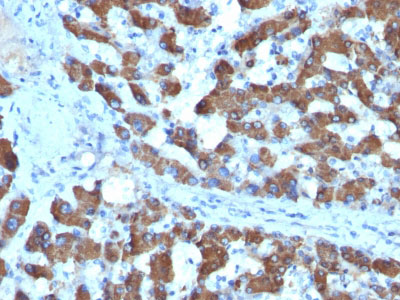CPS1 / Carbamoyl-Phosphate Synthetase (Hepatocellular Marker) Antibody - With BSA and Azide
Mouse Monoclonal Antibody [Clone SPM615 ]
- 产品详情
- 实验流程
- 背景知识
Application
| IHC, IF |
|---|---|
| Primary Accession | P31327 |
| Other Accession | 1373, 149252 |
| Reactivity | Human, Dog |
| Host | Mouse |
| Clonality | Monoclonal |
| Isotype | Mouse / IgG1 |
| Clone Names | SPM615 |
| Calculated MW | 164939 Da |
| Gene ID | 1373 |
|---|---|
| Other Names | Carbamoyl-phosphate synthase [ammonia], mitochondrial, 6.3.4.16, Carbamoyl-phosphate synthetase I, CPSase I, CPS1 |
| Application Note | IHC~~1:100~500 IF~~1:50~200 |
| Storage | Store at 2 to 8°C.Antibody is stable for 24 months. |
| Precautions | CPS1 / Carbamoyl-Phosphate Synthetase (Hepatocellular Marker) Antibody - With BSA and Azide is for research use only and not for use in diagnostic or therapeutic procedures. |
| Name | CPS1 |
|---|---|
| Function | Involved in the urea cycle of ureotelic animals where the enzyme plays an important role in removing excess ammonia from the cell. |
| Cellular Location | Mitochondrion. Nucleus, nucleolus. Cell membrane {ECO:0000250|UniProtKB:Q8C196}; Peripheral membrane protein; Extracellular side {ECO:0000250|UniProtKB:Q8C196} Note=Localizes to the cell surface of hepatocytes {ECO:0000250|UniProtKB:Q8C196} |
| Tissue Location | Primarily in the liver and small intestine. |
For Research Use Only. Not For Use In Diagnostic Procedures.
Provided below are standard protocols that you may find useful for product applications.
BACKGROUND
This MAb recognizes a protein of 165kDa, identified as carbamoyl phosphate synthetase 1 (CPS1). This mitochondrial enzyme catalyzes synthesis of carbamoyl phosphate from ammonia and bicarbonate. This reaction is the first committed step of the urea cycle, which is important in the removal of excess urea from cells.ĀDeficiency of CPS1 is an autosomal recessive disorder that causes hyperammonemia. CPS1 is a hepatocyte specific protein that localizes to the mitochondria of hepatocytes. It is a sensitive marker for distinguishing hepatocellular carcinomas (HCC) from other metastatic carcinomas as well as cholangio-carcinomas. HCC s occur primarily in the stomach, but they are also found in many other organs. CPS1 may also be a useful marker for intestinal metaplasia. Reportedly, strong expression of CPS1 correlates with smaller tumor size and longer patient survival. Occasionally, CPS1 is also found in gastric carcinomas as well as in a few other non-hepatic tumors.
REFERENCES
Haraguchi, Y., et al. 1991. Cloning and sequence of a cDNA encoding human carbamyl phosphate synthetase I: molecular analysis of hyperam- monemia. Gene 107: 335-340. | Ramos-Vara, J.A., et al. Histochem 2002; J. 34: 397-401. | Fan, Z., et al. Mod. Pathol 2003; 16: 137-144, 2003. |
终于等到您。ABCEPTA(百远生物)抗体产品。
点击下方“我要评价 ”按钮提交您的反馈信息,您的反馈和评价是我们最宝贵的财富之一,
我们将在1-3个工作日内处理您的反馈信息。
如有疑问,联系:0512-88856768 tech-china@abcepta.com.























 癌症的基本特征包括细胞增殖、血管生成、迁移、凋亡逃避机制和细胞永生等。找到癌症发生过程中这些通路的关键标记物和对应的抗体用于检测至关重要。
癌症的基本特征包括细胞增殖、血管生成、迁移、凋亡逃避机制和细胞永生等。找到癌症发生过程中这些通路的关键标记物和对应的抗体用于检测至关重要。 为您推荐一个泛素化位点预测神器——泛素化分析工具,可以为您的蛋白的泛素化位点作出预测和评分。
为您推荐一个泛素化位点预测神器——泛素化分析工具,可以为您的蛋白的泛素化位点作出预测和评分。 细胞自噬受体图形绘图工具为你的蛋白的细胞受体结合位点作出预测和评分,识别结合到自噬通路中的蛋白是非常重要的,便于让我们理解自噬在正常生理、病理过程中的作用,如发育、细胞分化、神经退化性疾病、压力条件下、感染和癌症。
细胞自噬受体图形绘图工具为你的蛋白的细胞受体结合位点作出预测和评分,识别结合到自噬通路中的蛋白是非常重要的,便于让我们理解自噬在正常生理、病理过程中的作用,如发育、细胞分化、神经退化性疾病、压力条件下、感染和癌症。






